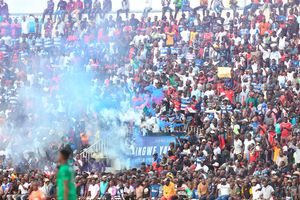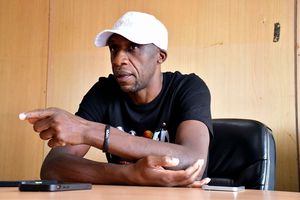
Referee Edina Alves Batista check the VAR screen for a penalty during the Women's Euro 2025 Group C match between Denmark and Sweden at Stade de Geneve, Geneva, Switzerland on July 4, 2025.
Seeing it to believe it was not enough to make it unbelievable at how technology continues to transform football. If you have been following the 2025 Fifa Club World Cup, you must have noticed that football referees are now full-blown production studios. Their arsenal of law-enforcing gadgets and tools has expanded to include a bodycam.
In addition to carrying a whistle, cards, a pen, a coin, a can of vanishing spray, and wearing a watch and a communication headset, football referees now have all their movements and actions kept under surveillance by a mini-camera attached to their earpiece.
The lens race in football has caught up with referees and while to the ever-conservative football fan this may seem yet another unwelcome invasion of technology in the sport; other stakeholders have praised the novel practice as key for enhancing the safety of match officials and improving their decision-making.

Esteban Andrada of CF Monterrey with referee Facundo Tello during the Fifa Club World Cup Round of 16 match between Borussia Dortmund and CF Monterrey at Mercedes-Benz Stadium in Atlanta, Georgia on July 1, 2025.
“The bodycam will help referees become more objective when making decisions,” Stephen Oduor, a Fifa Referees Instructor, says.
He argues that gone will be the days of referees saying, “that is what I saw”, after making a seemingly subjective decision. Their actions and decisions will now be corroborated using clips from their bodycams. In a way, the referees are now criss-crossing football pitches while carrying a snitching CCTV camera.
Oduor reckons that such material will also serve as essential teaching material during referees’ training.
“The video clips will help us evaluate a referee’s decision-making process and from that, new knowledge will be created that will assist referees to be more accurate in decision-making,” he says.
At the ongoing 2025 Fifa Club World Cup, clips from the bodycams referees wear have become part of TV production content. They show coin tosses, goals, and other key incidents as viewed by the referees. They continue to add to the puzzle of just how much content can be fit into a football broadcast spanning 90 minutes.
Beyond improving viewing experience, the use of referee bodycams has been reported to decrease cases of attacks and abuses towards match officials. These findings are from grassroots football matches in England where referees wore bodycams as part of a pilot programme last season, serving as evidence that their use at the Fifa Club World Cup is not really a new thing in football.
To go with referee bodycams, the Fifa Club World Cup continued with the practice started at the 2022 Fifa Club World Cup held in Morocco that saw Fifa trial in-stadium announcements of VAR decisions by match officials. This practice has so far been limited to Fifa tournaments and a few football jurisdictions, like the English FA, that have trialled it at select football matches.
The in-stadium VAR decision announcements at the Fifa Club World Cup have been a complement to stadium screens showing the incidents that referee review on pitch-side monitors reserved for their use.
Oduor supposes that if the practice becomes mainstream; it will reduce tension among fans in the stadium as, like fans watching the match on television, they will be kept in the loop on the incident being reviewed. However, he does not consider the practice as impacting on a referee’s decision-making ability.

Al Hilal's Sergej Milinkovic-Savic and Ruben Neves appeal to referee Danny Makkelie during the Fifa Club World Cup quarter final match against Fluminense at Camping World Stadium in Orlando, Florida on July 4, 2025.
“The fact that the fans are also watching the same images as the referee on the stadium screens should not interfere with their decision making process. A referee just needs to be accurate when making a decision,” he asserts.
Substitution tablets are the other gadgets that are making the 2025 Fifa Club World Cup a sports technology expo. Their use has eliminated the need of team managers to fill short forms when making substitutions. Those forms are usually handed over to the fourth official but with the introduction of substitution tablets, there will be no contact between the reserve referees and team managers as Oduor explains.
“Team managers will only need to key in the changes they want to make into their tablets. The reserve referee will receive a notification on his tablet then initiate effecting of the team’s decision to make a substitution.”
Victor Nyaoro, the former team manager of Gor Mahia, hailed the development as an upgrade on the manual process of making substitutions and he cannot wait for its introduction in Kenyan football.
“A lot of operations in Kenyan football have been digitised. There is less paperwork and when the substitution tablets come, I believe we will all appreciate the convenience they will bring,” he says.
Discussions with Nyaoro and Oduor on use of substitution tablets also revealed that their use will reduce clerical errors by reserve referees. Such clerical errors led to ambiguity in match reporting by referees where a substituted player would be recorded as having scored a goal or cautioned for a reckless tackle a few minutes after their substitution.
These errors arose when reserve referees recorded the minute of a player’s substitution as the time they received the substitution form from a team manager instead of the time the player actually left the pitch. In some instances, the time between a team manager handing over a substitution form and a player leaving the pitch can be as long as five minutes, enough time for a player whose substitution is pending to score a goal, be flagged offside, or collect a booking for an offence that can only be committed by an on-field player.

Match officials, led by centre referee Drew Fischer (second right), before the match Fifa Club World Cup Group G match between Wydad Casablanca v Al Ain at Audi Field, Washington, DC on June 26, 2025.
While Nyaoro and Oduor hope for such technological advancements to make their entry in Kenyan football, the costs of implementing them may delay their use in FKF Premier League matches.
For instance, Kenyan football is yet to embrace use of goal-line technology and VAR. Per a Business Daily report in 2012, Fifa had estimated the cost of installing goal-line technology at Sh14 million to Sh16 million.
According to other sources, the cost of operating it in every match could be as high as Sh700,000. It is such expenses that discouraged the Spanish La Liga from implementing it, arguing that VAR can serve the same purpose. The cost of installing and operating VAR is within the same margins.
Still, with Kenya set to host 2024 Chan and 2027 Afcon together with Tanzania and Uganda, installations that support VAR technology will have to be set up at Kasarani and Nyayo National Stadium.
It remains to be seen if their subsequent use in Kenyan league matches will be a legacy of hosting the two competitions. It is only then that Kenyan football will have truly caught up with practices that make modern football a big sport obsessed with small details.





